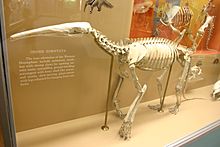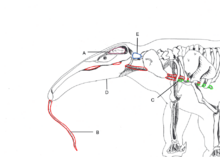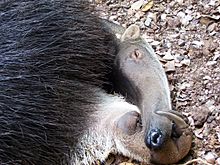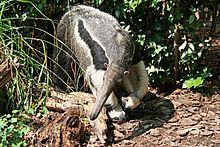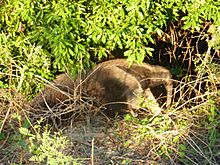Giant Anteater facts for kids
Quick facts for kids Giant anteater |
|
|---|---|
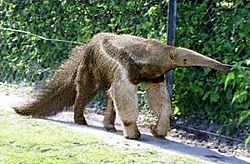 |
|
| Conservation status | |
| Scientific classification | |
| Kingdom: | |
| Class: | |
| Superorder: | |
| Order: | |
| Family: | |
| Genus: |
Myrmecophaga
|
| Binomial name | |
| Myrmecophaga tridactyla Linnaeus, 1758
|
|
The Giant Anteater, Myrmecophaga, is an animal that lives in Central and South America.
It is known as ant bear It is famous because it is the only mammal without teeth. It eats a lot of ants, hence the name. It is the largest anteater: its length is between 182cm and 217cm. Males weigh between 33 and 41 kg, female are 27 and 39 kg. This species is mostly terrestrial, in contrast to other living anteaters and sloths which are arboreal or semi-arboreal. It forages in open areas and rests in more forested habitats. It feeds primarily on ants and termites, using its foreclaws to dig them up and its long, sticky tongue to collect them.
Contents
Description
The giant anteater can be identified by its large size, elongated muzzle, and long bushy tail. It has a total body length of 182–217 cm (5.97–7.12 ft). Males weigh 33–41 kg (73–90 lb) and females weigh 27–39 kg (60–86 lb), making the giant anteater the largest extant species in its suborder. The head of the giant anteater, at 30 cm (12 in) long, is particularly elongated, even when compared to other anteaters. Its tubular snout, which ends in its tiny mouth opening and nostrils, takes up most of its head. Its eyes and ears are relatively small. It has poor eyesight, but its sense of smell is 40 times more sensitive than that of humans. Giant anteaters can live around 16 years in captivity.
Even for an anteater, the neck is especially thick compared to the back of the head, and a small hump can be found at the back of the neck. The coat is mostly grey and salted with white. The forelimbs are white, with black bands around the wrists, while the hindlimbs are dark. Thick black bands with white outlines stretch from throat to shoulder, ending in triangular points. The body ends in a brown tail. The coat hairs are long, especially on the tail, which makes the tail look larger than it actually is. A stiff mane stretches along the back. The bold pattern was thought to be disruptive camouflage, but a 2009 study suggests it is warning coloration. While adult males are slightly larger and more muscular than females, with wider heads and necks, visual sex determination can be difficult.
The giant anteater has broad ribs. Despite its specific name, it has five toes on each foot. Four toes on the front feet have claws, which are particularly elongated on the second and third digits. It walks on its front knuckles, similar to the African apes, specifically gorillas and chimpanzees. Doing this allows the giant anteater to keep its claws out of the way while walking. The middle digits, which support most of its weight, are extended at the metacarpophalangeal joints and bent at the interphalangeal joints. Unlike the front feet, the hind feet have short claws on all five toes and walk plantigrade. As a "hook-and-pull" digger, the giant anteater's enlarged supraspinous fossa gives the teres major more leverage—increasing the front limbs' pulling power—and the triceps muscle helps power the flexion of the thickened third digit of the front feet.
The giant anteater has a low body temperature for a mammal, about 33 °C (91 °F), a few degrees lower than a typical mammalian temperature of 36–38 °C (97-100 °F). Xenarthrans in general tend to have lower metabolic rates than most other mammals, a trend thought to correlate with their dietary specializations and low mobility.
Feeding anatomy
The giant anteater has no teeth and is capable of only very limited jaw movement. It relies on the rotation of the two halves of its lower jaw, held together by a ligament at the tip, to open and close its mouth. This is accomplished by its masticatory muscles, which are relatively underdeveloped. Jaw depression creates an oral opening large enough for the slender tongue to flick out. It is typically 60 cm (24 in) long and is triangular posteriorly, rounded anteriorly, and ends in a small, rounded tip. The tongue is covered in backward-curving papillae and coated in thick, sticky saliva secreted from its enlarged salivary glands, which allows the giant anteater to collect insects with it.
The tube-like rostrum and small mouth opening restrict the tongue to protrusion-retraction movements. During feeding, the tongue moves in and out around 160 times per minute (nearly three times per second). According to biologist Virginia Naples, these movements are powered by the unique musculature of the giant anteater's long, large, and flexible hyoid apparatus. Conversely, biologist Karen Reiss states that the anteater's tongue has no attachments to the hyoid and this is what allows it to flick its tongue at such speeds. The animal relies on the orientation of its head for aim. When fully extended, the tongue can reach 45 cm (18 in), longer than the length of the skull. The buccinators allow it to slide back in without losing attached food and tighten the mouth to prevent food from escaping as it extends. When retracted, the tongue is held in the oropharynx by the secondary palate, preventing it from blocking respiration. This retraction is aided by the long sternoglossus muscle, which is formed by the fusion of the sternohyoid and the hyoglossus, and does not attach to the hyoid. Thus, the tongue is directly anchored to the sternum.
Giant anteaters swallow at a much higher rate than most other mammals; when feeding, they swallow almost continuously. Before being swallowed, insects are crushed against the palate. The giant anteater's stomach, similar to a bird's gizzard, has hardened folds and uses strong contractions to grind up the insects. The digestive process is assisted by small amounts of ingested sand and soil. The giant anteater cannot produce stomach acid of its own, but uses the formic acid of its prey for digestion.
Distribution and status
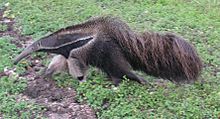
The giant anteater is native to Central and South America. Its known range stretches from Honduras to northern Argentina, and fossil remains have been found as far north as northwestern Sonora, Mexico. It is largely absent from the Andes and has been extirpated in Uruguay. It may also be extirpated in Belize, Costa Rica, and Guatemala. The species can be found in a number of habitats including both tropical rainforests and xeric shrublands, provided enough prey is present to sustain it.
The species is listed as Vulnerable by the IUCN, due to the number of regional extirpations, and under Appendix II by CITES, tightly restricting trade in specimens of the animal. Between 2000 and 2010, the total population declined by 30%. In 1994, some 340 giant anteaters died due to wildfires at Emas National Park in Brazil. The animal is particularly vulnerable to fires due to its slow movement and flammable coat.
Human-induced threats include collision with vehicles, attacks by dogs, and destruction of habitat. The giant anteater is commonly hunted in Bolivia, both for sport and sustenance. The animal's thick, leathery hide is used to make equestrian equipment in the Chaco. In Venezuela, it is hunted for its claws. Giant anteaters are killed for safety reasons, due to their reputation as dangerous animals. The giant anteater remains widespread. Some populations are stable and the animal can be found in various protected areas in the Amazon and the Cerrado. It is officially protected in some Argentine provinces as a national heritage species.
Behavior and ecology
The giant anteater may use multiple habitats. A 2007 study of giant anteaters in the Brazilian Pantanal found the animals generally forage in open areas and rest in forested areas, possibly because forests are warmer than grasslands on cold days and cooler on hot days. Giant anteaters can be either diurnal or nocturnal. A 2006 study in the Pantanal found those anteaters to be mostly nocturnal: they are most active during nighttime and early morning, and retire as the temperature rises. On colder days, they start and end periods of activity earlier, shifting them into daylight hours, and may become diurnal. Diurnal giant anteaters have been observed at Serra da Canastra. Nocturnality in anteaters may be a response to human disturbances.
Giant anteaters typically rest in dense brush, but may use tall grass on cooler days. They carve a shallow cavity in the ground for resting. The animal sleeps curled up with its bushy tail folded over its body. The tail serves both to conserve body heat and as camouflage. One anteater was recorded sleeping with its tail stretched out on a sunny morning with an ambient temperature of 17 °C (63 °F); possibly it was positioned this way to allow its body to absorb the sun's rays for warmth.
Giant anteaters are good swimmers and are capable of moving through wide rivers. They have been observed to bathe. They are also able to climb and have been recorded ascending both termite mounds and trees while foraging. One individual was observed holding onto a branch with its feet just touching the ground.
Spacing
Giant anteaters' home ranges vary in size depending on the location. At Serra da Canastra National Park in Brazil, female anteaters have home ranges around 3.67 km2 (910 acres), while males live in home ranges of 2.74 km2 (680 acres). In other parts of Brazil, anteaters may have 9 km2 (2,200 acres) ranges. Anteaters from Venezuela have been recorded living in home ranges as large as 25 km2 (6,200 acres). Individuals mostly live alone, except for females that nurse their young and males courting females. Anteaters communicate their presence and status with secretions from their anal glands. They also advertise their presence to other individuals though tree markings and urine. They appear to be able to recognize each other's saliva by scent.
Females appear to be more tolerant of females than males are of males, leading to greater overlap in female home ranges. Males are more likely to engage in agonistic behaviors, such as slowly circling each other, chasing, or actual fighting. Circling anteaters may cry a drawn-out "harrr". In combat, they slash at each other with their claws and wrestle each other to the ground. Fighting anteaters may emit roars or bellows. Males are possibly territorial.
Foraging and predation
This animal is an insectivore, feeding mostly on ants or termites. In areas that experience seasonal flooding, like the grassy plains of the Venezuelan llanos, anteaters mainly feed on ants, because termites are less available. Conversely, anteaters at Emas National Park eat mainly termites, which occur in high density on the grasslands. At Serra da Canastra, anteaters switch between eating mainly ants during the wet season (October to March) and termites during the dry season (May to September).
Anteaters track prey by their scent. After finding a nest, the animal tears it open with its long fore claws and inserts its long, sticky tongue to collect its prey. An anteater spends one minute on average feeding at a nest, visiting up to 200 nests in one day and consuming as many as 30,000 insects. The anteater may be driven away from a nest by the chemical or biting attacks of soldiers. Some termite species rely on their fortified mounds for protection and many individuals escape while the predator digs. These modes of defense prevent the entire colony from being eaten in one anteater attack.
Other prey include the larvae of beetles and western honey bees that have located their hives in termite mounds. Anteaters may target termite mounds with bee hives. In captivity, anteaters are fed mixtures made of milk, eggs, mealworms, and ground beef. To drink, an anteater may dig for water when no surface water is available, creating waterholes for other animals. Giant anteaters are primarily prey for jaguars and pumas. They typically flee from danger by galloping, but if cornered, will rear up on their hind legs and slash at the attacker. The giant anteater's front claws are formidable weapons, capable of killing a jaguar.
Although they are shy and typically attempt to avoid humans, giant anteaters can inflict severe wounds with their front claws and have been known to seriously injure or kill humans who corner and threaten them. Between 2010 and 2012, two hunters were killed by giant anteaters in Brazil; in both cases, the hunters were agitating and wounding cornered animals and the attacks appeared to be defensive behaviors. In April 2007, an anteater at the Florencio Varela Zoo mauled a zookeeper with its front claws.
Reproduction and parenting
Giant anteaters can mate throughout the year. Gestation lasts around 190 days and ends with the birth of a single pup, which typically weighs around 1.4 kg (3.1 lb). Females give birth standing upright.
Pups are born with eyes closed and begin to open them after six days. The mother carries its dependent pup on its back. The pup's black and white band aligns with its mother's, camouflaging it. The young communicate with their mothers with sharp whistles and use their tongues during nursing. After three months, the pup begins to eat solid food and is fully weaned by ten months. The mother grooms her offspring during rest periods lasting up to an hour. Grooming peaks during the first three months and declines as the young reaches nine months of age, ending by ten months. The decline mirrors that of the weakening bond between mother and offspring; young anteaters usually become independent by nine or ten months. Anteaters are sexually mature in 2.5–4 years.
In culture
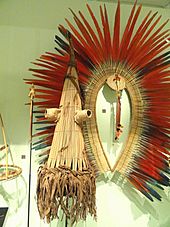
In the mythology and folklore of the indigenous peoples of the Amazon Basin, the giant anteater is depicted as a trickster foil to the jaguar, as well as a humorous figure due to its long snout. In one Shipib tale, an anteater challenged a jaguar to a breath-holding contest under water, which the jaguar accepted. After the two removed their pelts and submerged, the anteater jumped out of the water and stole the jaguar's pelt, leaving the jaguar with the anteater's pelt. In a Yarabara myth, the evil ogre Ucara is transformed into one by the sun. This myth emphasizes the nearly immobile nature of the anteater's mouth, which was considered a burden. The Kayapo people wear masks of various animals and spirits, including the anteater, during naming and initiation ceremonies. They believe women who touched anteater masks or men who stumbled while wearing them would die or receive some sort of physical disorder.
During the Spanish colonization of the Americas, the giant anteater was one of many native fauna taken to Europe for display. At first, Europeans believed all anteaters were female and mated with their noses, a misconception corrected by naturalist Félix de Azara. In the 20th century, Salvador Dalí wrote imaginatively that the giant anteater "reaches sizes bigger than the horse, possesses enormous ferocity, has exceptional muscle power, is a terrifying animal."
The 1940 Max Fleischer cartoon Ants in the Plants features a colony of ants fighting off a villainous anteater. Released during the Phoney War, the film may have alluded to France's Maginot Line.
An anteater is also a recurring character in the comic strip B.C.. This character was the inspiration for Peter the Anteater, the University of California, Irvine team mascot.
The Flash cartoon Happy Tree Friends features an anteater named Sniffles.
In the Stephen King miniseries Kingdom Hospital, the character Antubis appears in the form of an anteater-like creature with razor-sharp teeth.
Images for kids
See also
 In Spanish: Oso hormiguero gigante para niños
In Spanish: Oso hormiguero gigante para niños




